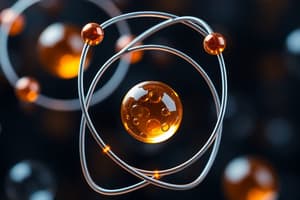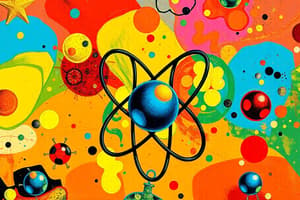Podcast
Questions and Answers
According to Hund's Rule, how should electrons be distributed in orbitals of the same energy?
According to Hund's Rule, how should electrons be distributed in orbitals of the same energy?
- All electrons should be paired in the first orbital before moving to the next.
- Electrons should fill each orbital singly before pairing. (correct)
- Electrons can fill any orbital randomly without following a specific order.
- All electrons must occupy the lowest energy orbital first before moving higher.
Why does the electron configuration for chlorine show 3p has 5 electrons rather than 6?
Why does the electron configuration for chlorine show 3p has 5 electrons rather than 6?
- The 3p orbital can only hold a maximum of 5 electrons.
- The chlorine atom does not have enough protons to hold more electrons.
- Chlorine prefers to have unpaired electrons for stability.
- The energy levels dictate that lower energy orbitals fill first. (correct)
What do you call atoms that have unpaired electrons in their orbital diagrams?
What do you call atoms that have unpaired electrons in their orbital diagrams?
- Stable atoms
- Diamagnetic atoms
- Paramagnetic atoms (correct)
- Magnetically neutral atoms
In the orbital filling sequence for chlorine, how many total electrons are in the 3p orbital?
In the orbital filling sequence for chlorine, how many total electrons are in the 3p orbital?
What is the significance of the term 'Aufbau Principle' in relation to electron configuration?
What is the significance of the term 'Aufbau Principle' in relation to electron configuration?
What term did Democritus use to refer to the smallest indivisible objects?
What term did Democritus use to refer to the smallest indivisible objects?
Which scientist proposed that matter consists of indivisible atoms?
Which scientist proposed that matter consists of indivisible atoms?
What model of the atom was J.J. Thompson known for?
What model of the atom was J.J. Thompson known for?
Which experimental setup did Ernest Rutherford use to discover the nucleus?
Which experimental setup did Ernest Rutherford use to discover the nucleus?
What was one of the key features of the Plum Pudding Model?
What was one of the key features of the Plum Pudding Model?
Which atomic model introduced the concept of nuclei containing protons and electrons?
Which atomic model introduced the concept of nuclei containing protons and electrons?
What is the significance of quantum numbers in atomic structure?
What is the significance of quantum numbers in atomic structure?
What does the term 'electron configuration' refer to?
What does the term 'electron configuration' refer to?
What determines the location and energy of every electron in an atom?
What determines the location and energy of every electron in an atom?
Which of the following is NOT a type of atomic orbital?
Which of the following is NOT a type of atomic orbital?
What does the principal quantum number (n) indicate?
What does the principal quantum number (n) indicate?
How can we describe the location of electrons in an atom?
How can we describe the location of electrons in an atom?
What is the significance of an atom's core?
What is the significance of an atom's core?
Which statement is true regarding the probability of finding an electron?
Which statement is true regarding the probability of finding an electron?
Which of the following statements about atomic orbitals is incorrect?
Which of the following statements about atomic orbitals is incorrect?
What is the relationship between the principal quantum number and the distance from the nucleus?
What is the relationship between the principal quantum number and the distance from the nucleus?
What behavior is characteristic of the electrons in an atom based on their energy levels?
What behavior is characteristic of the electrons in an atom based on their energy levels?
Who were the first people to propose the idea of atoms?
Who were the first people to propose the idea of atoms?
According to the Bohr model, how are electrons situated in an atom?
According to the Bohr model, how are electrons situated in an atom?
What is primarily described by the Quantum Mechanical Model?
What is primarily described by the Quantum Mechanical Model?
Which scientist is credited with the discovery of protons?
Which scientist is credited with the discovery of protons?
How many types of orbitals are there in the Quantum Mechanical Model?
How many types of orbitals are there in the Quantum Mechanical Model?
What happens to the probability of finding an electron as the distance from the nucleus increases?
What happens to the probability of finding an electron as the distance from the nucleus increases?
In the context of atomic structure, what does 'nucleus' refer to?
In the context of atomic structure, what does 'nucleus' refer to?
How did early ideas about atoms represent atomic structure?
How did early ideas about atoms represent atomic structure?
Which statement accurately describes the density of an electron's location near the nucleus?
Which statement accurately describes the density of an electron's location near the nucleus?
What was a significant contribution of Niels Bohr to atomic theory?
What was a significant contribution of Niels Bohr to atomic theory?
What does the angular momentum quantum number (l) describe?
What does the angular momentum quantum number (l) describe?
If an electron has a principal quantum number (n) of 3, which of the following values can l take?
If an electron has a principal quantum number (n) of 3, which of the following values can l take?
Which orbital corresponds to l = 1?
Which orbital corresponds to l = 1?
The magnetic quantum number (ml) can take values based on l. What are the possible values when l = 2?
The magnetic quantum number (ml) can take values based on l. What are the possible values when l = 2?
How many electrons can the d-orbitals hold?
How many electrons can the d-orbitals hold?
According to the Pauli Exclusion Principle, what is true about electrons in an atom?
According to the Pauli Exclusion Principle, what is true about electrons in an atom?
Which quantum number indicates the spin of an electron?
Which quantum number indicates the spin of an electron?
What is the maximum number of electrons that can occupy f-orbitals?
What is the maximum number of electrons that can occupy f-orbitals?
Which of the following electric properties is wrong regarding the quantum numbers?
Which of the following electric properties is wrong regarding the quantum numbers?
Flashcards
Atomic Theory
Atomic Theory
The idea that matter is made up of tiny, indivisible particles.
Early Atomic Theory
Early Atomic Theory
Proposed by Democritus and Leucippus, it was the first idea to suggest the existence of atoms.
Nuclear Model
Nuclear Model
A model of the atom where the positive charge is concentrated in the center, with negatively charged electrons orbiting around it.
Charge Concentration
Charge Concentration
Signup and view all the flashcards
Electron Cloud
Electron Cloud
Signup and view all the flashcards
Bohr Model
Bohr Model
Signup and view all the flashcards
Proton
Proton
Signup and view all the flashcards
Neutron
Neutron
Signup and view all the flashcards
Orbitals
Orbitals
Signup and view all the flashcards
Quantum Mechanical Model
Quantum Mechanical Model
Signup and view all the flashcards
Atom
Atom
Signup and view all the flashcards
Democritus's Model of the Atom
Democritus's Model of the Atom
Signup and view all the flashcards
Dalton's Model of the Atom
Dalton's Model of the Atom
Signup and view all the flashcards
Plum Pudding Model
Plum Pudding Model
Signup and view all the flashcards
Nuclear Model of the Atom
Nuclear Model of the Atom
Signup and view all the flashcards
Electron Orbitals
Electron Orbitals
Signup and view all the flashcards
Quantum Numbers
Quantum Numbers
Signup and view all the flashcards
Electron Configuration
Electron Configuration
Signup and view all the flashcards
Principal Quantum Number (n)
Principal Quantum Number (n)
Signup and view all the flashcards
Heisenberg's Uncertainty Principle
Heisenberg's Uncertainty Principle
Signup and view all the flashcards
Atomic Orbitals
Atomic Orbitals
Signup and view all the flashcards
Orbital Shapes (s, p, d, f)
Orbital Shapes (s, p, d, f)
Signup and view all the flashcards
Atomic Nucleus
Atomic Nucleus
Signup and view all the flashcards
Quantum Mechanical Model of the Atom
Quantum Mechanical Model of the Atom
Signup and view all the flashcards
Aufbau Principle
Aufbau Principle
Signup and view all the flashcards
Hund's Rule
Hund's Rule
Signup and view all the flashcards
Paramagnetic
Paramagnetic
Signup and view all the flashcards
Diamagnetic
Diamagnetic
Signup and view all the flashcards
Angular Momentum Quantum Number (l)
Angular Momentum Quantum Number (l)
Signup and view all the flashcards
Orbital Shapes based on Angular Momentum (l)
Orbital Shapes based on Angular Momentum (l)
Signup and view all the flashcards
Magnetic Quantum Number (ml)
Magnetic Quantum Number (ml)
Signup and view all the flashcards
Number of Orbitals determined by ml
Number of Orbitals determined by ml
Signup and view all the flashcards
Spin Quantum Number (ms)
Spin Quantum Number (ms)
Signup and view all the flashcards
Pauli Exclusion Principle
Pauli Exclusion Principle
Signup and view all the flashcards
n and l relationship
n and l relationship
Signup and view all the flashcards
Orbital Shapes
Orbital Shapes
Signup and view all the flashcards
Study Notes
Atomic Structure of Matter
- Democritus proposed the concept of "atomos" (uncuttable particles) with varying sizes and shapes.
- Dalton's atomic model (1808) posited atoms as indivisible particles combining to form different compounds.
- The Plum Pudding model (1904) depicted atoms with negatively charged electrons embedded in a positively charged "dough".
- Rutherford's nuclear model (1911) suggested a dense, positively charged nucleus at the center of the atom, with electrons orbiting around it, largely empty space.
- Bohr's model (1913) illustrated electrons orbiting the nucleus in specific energy levels and pathways, similar to planets orbiting a star.
- The Quantum Mechanical Model (1920s), developed by Schrödinger, describes electrons as existing in orbitals, defined regions of space where there's a high probability of finding them.
- Subatomic particles include protons (positively charged), neutrons (neutral), and electrons (negatively charged). Protons and neutrons reside in the nucleus.
- Atomic orbitals are described by quantum numbers, which dictate the shape, size, and energy of orbitals.
- Principal quantum number (n) represents the energy level.
- Angular momentum quantum number (l) describes the shape.
- Magnetic quantum number (ml) specifies the orientation in space.
- Spin quantum number (ms) describes the spin of the electron, either +1/2 or -1/2.
- The Aufbau principle dictates electron filling order in orbitals, starting from the lowest energy level.
- Hund's rule suggests that electrons fill each orbital individually before doubling up.
- Paramagnetic atoms have unpaired electrons and are attracted to magnetic fields.
- Diamagnetic atoms have all paired electrons and are not significantly affected by magnetic fields
Studying That Suits You
Use AI to generate personalized quizzes and flashcards to suit your learning preferences.




